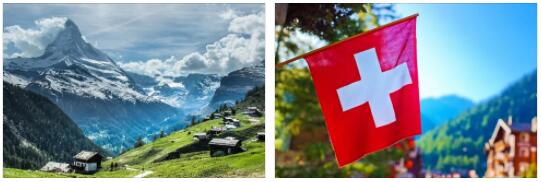Switzerland is a small and quite expensive travel destination in the heart of Europe, nestled between France in the west, Germany in the north, Austria in the east and Italy in the south. There are a variety of excursion destinations in the beautiful landscape, both in summer and in winter. See andyeducation.com for education in Switzerland.
| Capital City | Bern |
| Size | 41.285 km² |
| Resident | 8.482.000 |
| Official Language | German, French, Italian, Romansh |
| Currency | Swiss franc |
| Time Zone | UTC+1/+2 |
| Telephone Area Code | +41 |
Fast facts to know
- The oldest chocolate factory that is still in operation today is in Switzerland.
- In Switzerland it is customary to use the first name at work.
- Swiss are very polite.
- A vignette is required on Swiss motorways.
- Traffic violations result in high fines.
- EU citizens can enter Switzerland with an identity card or passport.
- The German plugs (Schuko plugs) do not fit into the Swiss sockets.
- There are more than 1,500 lakes in Switzerland.
- 60% of the electricity in Switzerland is generated by hydropower.
- Swiss cannabis consumption is one of the highest in the world.
- The Swiss national flag is a square.
- The highest mountain in Switzerland is the Dufourspitze in the canton of Valais with a height of 4,634 meters above sea level.
- Switzerland is a very safe, but also expensive travel destination.
- Life expectancy in Switzerland is high.
- Whether the Swiss national hero Wilhelm Tell lived or not can neither be conclusively proven nor disproved.
Exciting cities in Switzerland
- Basel
- Bern
- Bellinzona
- Geneva
- Locarno
- Lugano
- Luzern
- Montreux
- St. Gallen
- Winterthur
- Zürich
- Ascona
- elastic
- Soglio
history of Switzerland
- Inhabited since the Old Stone Age (Palaeolithic).
- Integrated into the Roman Empire as the Roman Empire expanded.
- Romanization of the population.
- After the fall of the Roman Empire, settlement by the Germanic tribes of the Burgundians and Alemanni.
- Switzerland becomes part of the Frankish Empire.
- Important noble families: Habsburg, Kyburg, Lenzburg and Rudolfinger.
- 13th century: Old Confederation as a loose alliance of valley communities in Central Switzerland.
- Expansion of the Confederation over the next few centuries.
- From 1515 Switzerland pursues a policy of neutrality.
- 1648 Separation of Swiss cantons from the Holy Roman Empire with subsequent independence.
- 1653 Swiss Peasants’ War.
- 1798 After a brief resistance, it was occupied by France and incorporated into its sphere of influence as a subsidiary republic under the name “Helvetic Republic”.
- 1803 Switzerland gets a federal constitution with autonomous cantons.
- 1847 Sonderbund War (civil war; last war on Swiss soil).
- 1848 Founding of the federal state.
- 1866 Swiss Jews are granted full civil rights and freedom of settlement throughout Switzerland.
- 1874 constitutional reform.
- During the First World War, Switzerland maintained armed neutrality.
- 1992 The government’s attempt to join the European Economic Area (EEA) fails in a referendum.
- 2002 Accession to the United Nations (UNO).
- 2005 Switzerland joins the Schengen and Dublin agreements.
Climate & travel weather in Switzerland
- temperate climate.
- North cooler and wetter than in the Alpine valleys or south of the Alps.
- In the Jura in the north-west there is considerably more precipitation than in the Engadin in the east or in Valais in the south-west.
- Southern Switzerland: Mediterranean influences and milder climate.
- Recommended travel time:
- Easily accessible all year round.
- Ski season: November to April.
Ideas for excursions in Switzerland
- drift bridge
- Schloss Chillon
- Viewpoint on Muottas Muragl
- Hiking in the Swiss National Park Fuorcla Val Sassa
- Marvel at the crystal cirques of Blausee
- With the Schilthornbahn to the Piz Gloria
- Tobogganing in Grindelwald
- Baden im Cauma See
- St. Beatus Caves on Lake Thun
- enjoy winter sports
- Eispaläste am Schwarzsee
- Idyllisches Sertig Dörfli
- Medieval town of Gruyères with a castle
- Explore museums in Basel
Eating & drinking in Switzerland
- Impressive variety of culinary products with influences from Alsace, France, Italy.
- The Swiss like simple, down-to-earth food.
- Very popular: Z’Vieri-Plättli (four o’clock plate) with cheese, dried meat, bacon, butter, bread.
- The Swiss usually attach great importance to enjoyable and healthy food.
- Breakfast: Croissons, braid, jams, good coffee.
- Midday mostly warm lunch, often canteen food.
- In the evening often raclette, fondue, in summer like Mediterranean, light fare.
- Known for excellent chocolate and cheese.
- Raclette and cheese fondue very popular.
- Perch is a popular food fish.
- There are cakes in all variations, dough, fruit and nut mixtures.
- There are some very good wines.
- Typical dishes:
- Zürcher Geschnetzeltes (veal and mushrooms, cream and white wine sauce).
- Älplermagronen (macaroni with cheese)
- Alphüttensuppe (heavy vegetable soup with macaroni, cream and grated cheese).
- Chügelipatete (oven-baked veal patty).
- Gitzichüechli (kiat fillet pieces baked in flour dough).
- Maritsuppe (hearty Bernese soup with peas, potatoes, Gnagi, salted pork knuckle).
- Olma-Bratwurst (Bratwurst from St. Gallen grilled on charcoal).
- Papet vaudois (potatoes and leeks stewed in lard with smoked pork sausage).
- Pizzocheri (Graubündner spaetzle, cooked in vegetable soup, served mixed with vegetables).
- Zigerhörnli (dough pieces, baked with Schabziger, a skimmed milk cheese made with herbs).
- Engadiner Nusstorte
- Bircher Müsli
Particularly scenic
- Lake Geneva
- Luganersee
- Rheinfall
- Aletschgletscher
- Lake Lucerne
- Matterhorn
- Oberengadin
- Jungfrau region
- Lake Maggiore
- Rheinschlucht Ruinaulta
- Viamala Gorge
